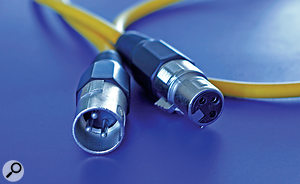Hugh Robjohns
I work in a facility where AES3 110Ω cables have been used to connect some splitter outputs to mic preamps. What kind of influence, if any, can this ‘impedance mismatching’ have on the signal quality? I find the sound from the vocal booth generally quite harsh and aggressive, with excessive sibilance. To add extra complexity to the picture, the preamps are Focusrite Isa 430s with variable input impedance! Thanks for your help.

Vincent Ladriere, via email.
Not all balanced XLR cables have the same ‘characteristic impedance’ — but is this something the home recordist really needs to concern themselves with?Not all balanced XLR cables have the same ‘characteristic impedance’ — but is this something the home recordist really needs to concern themselves with?SOS Technical Editor Hugh Robjohns replies: In short, none at all. There is no impedance mismatching here because analogue microphones and preamplifiers do not operate in an impedance–matched environment. They operate within a strict voltage–matched interface, where the load impedance is roughly 10 times higher than the source impedance. The ability to change the preamp’s input impedance affects the way the microphone is loaded, which in turn alters the tonality with some dynamic and transformer–coupled mics — but it still has nothing to do with a matched-impedance operating environment!
All cables have a ‘characteristic impedance’ and most balanced mic cables are around 100Ω or so. However, this nominal cable impedance only becomes significant and relevant when used to pass signals within an impedance–matched interface arrangement, and even then only for signal frequencies over 1MHz or so (ie. digital audio signals), or in cable runs over 10 of kilometres in length (as with telephone lines, for instance). None of these conditions apply in a simple studio mic-to-preamp connection, which is only a few 10 of metres long at most, carries no significant audio above 20kHz or so, and operates in a voltage–matched environment.
It’s worth noting that the AES decided upon the use of a nominal 110Ω cable impedance for the AES3 digital interface specification precisely because that is what most standard studio mic cables exhibit. The original idea was for people to be able to run AES3 digital audio using standard studio cables to make it a ‘familiar and friendly’ interface. Unfortunately, that was a flawed concept, mainly because standard studio mic cables have way too high a capacitance for conveying digital signals in the MHz region, and that’s why very low–capacitance balanced cable is available for AES3 applications. However, the low capacitance is not a bad thing for analogue audio either, and so it is very common to standardise on AES3–compatible cabling when wiring new installations.
I can guarantee that the source of the harsh, aggressive, and sibilant sound you’re complaining about has nothing to do with the cabling. I would suggest that it’s actually due to a combination of the vocal booth’s acoustics, the microphone choice, and the mic placement, and these are the areas in which you need to experiment to find a solution.
No comments:
Post a Comment